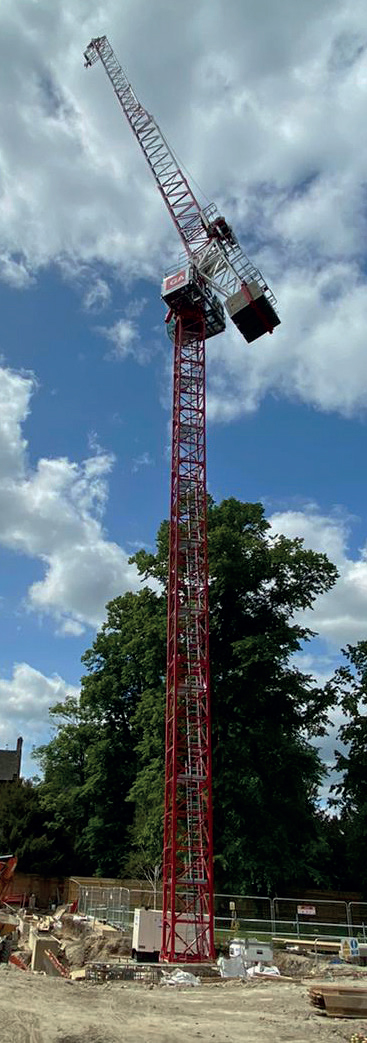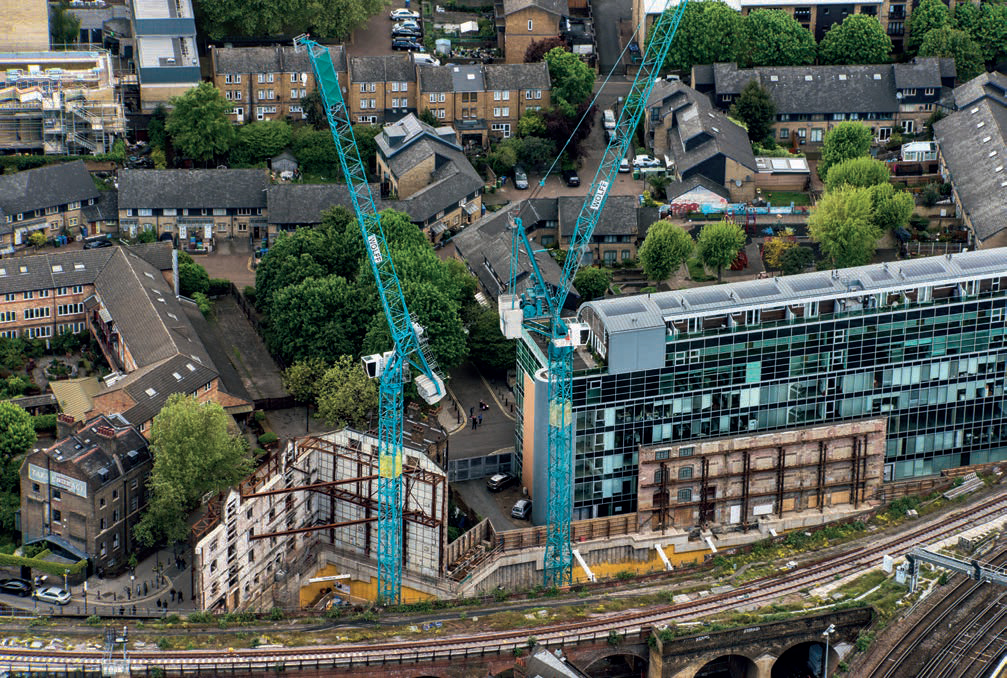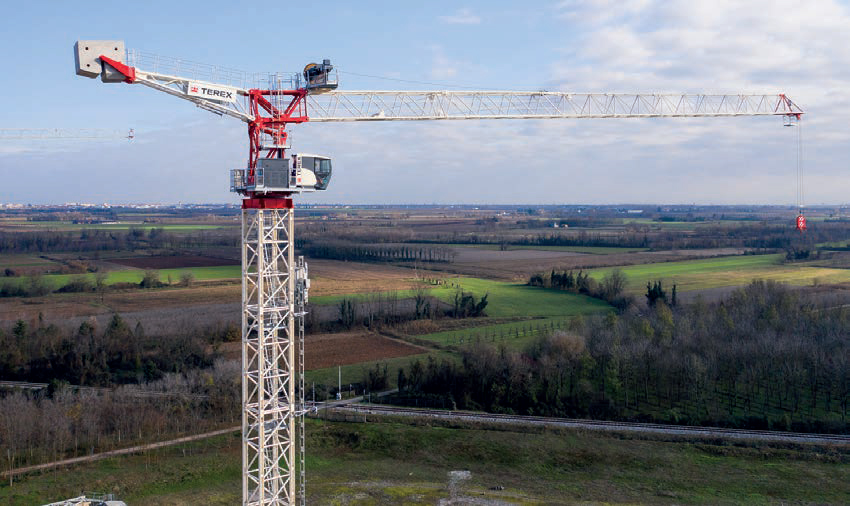Turning point
14 July 2020With a number of new entrants, the small market for hydraulic luffers has become crowded in the last few years. Is the evolution of this market posing a threat to traditional luffers? Sotiris Kanaris reports.
The hydraulic luffer is a very popular machine in the UK, with major tower crane rental companies having many units in their fleet. In the rest of the world, with the exception of Australia, industry players are not very familiar with it. As the current market seems limited, the question arises as to why so many manufacturers decided to enter it.
For years, German manufacturer Jost Cranes had a monopoly in the UK market. In 2009, Jaso launched its first model, following a request from its local customer Falcon Tower Crane Services. In 2012, Wolffkran launched its first model, while three years later Spanish manufacturer Saez introduced one. More recently, Potain, Terex, Raimondi and FMGru jumped on the bandwagon.
Dave Holder, European operations director, group rental fleet at Wolffkran, says the market requirements have remained fairly constant over the years. He explains that in terms of capacity, demand is still concentrated in the sub-250mt class. Holder identifies as the key drivers to the market: faster erection and dismantle times; increased working speeds; short out-of-service parking radius and price.
“The small luffing jib crane has enjoyed regional success when used on small footprint, congested city construction jobsites and this looks set to continue so long as the demand for those buildings remains. The market in the UK has been strong for these products and this is driven in part by the strict oversailing rights particular to the UK, although we are seeing some emergence of this issue in other territories which will possibly mean products of this design could find more customers in these other regions,” he says.
The hydraulic luffer could meet the requirements of many construction sites around the world. Manufacturers Cranes Today talked to mentioned a range of countries (other than the UK and Australia) where their hydraulic luffers have been sold or rented, including USA, Canada, Mexico, Russia, Germany, the Netherlands and Ireland.
Marketplace
The international sales potential of this crane type may be the reason behind the manufacturers’ investment and the decision by some to present units at the biggest trade fairs.
At this year’s ConExpo trade fair in Las Vegas, USA, Wolffkran and Potain had hydraulic luffers on display.
Wolffkran presented for the first time the Wolff 166 B US, an adaptation of its 166 B to comply with specific US regulations and individual state requirements.
“The modifications are based around cable and component compliance to US standards, revised duty charts into imperial units and specific OSHA requirements which are not present in other global regions,” says Holder.
The new Wolff 166 B US hydraulic luffer offers a maximum load capacity of 26,460lb (12t) in two-fall operation and 13,230lb in one-fall operation. The jib line-up ranges from 82ft (25m) to 180ft and can be extended in 16.4ft increments. With a 164ft jib it achieves a tip load capacity of 7,270lb. Equipped with a powerful 60kW hoist winch the Wolff 166 B US offers a hook path of 1,640ft and line speeds of up to 377ft/ min in one-fall operation and can be built up to a free-standing tower height of 306ft thanks to the modular Wolff tower system.
Many of the modifications for the US market, such as the improved edge protection and access dimensions, are now incorporated into the design of Wolffkran’s hydraulic luffers, conventional luffers and saddle jibs for sale around the world. Wolffkran’s hydraulic luffer portfolio also includes the 133 B model in two versions, 6t and 8t.
At ConExpo, Potain launched the MRH 175, which has a maximum capacity of 10t (11USt) and a maximum jib length of 55m.
Tip capacity is 1.5t when working with the full 55m jib, or 2.7t if fitted with 50m of jib. Maximum line speed is 215 m/min when working with the high-performance 90HPL25 hoist.
This was the second hydraulic model in Potain’s range, as it introduced the 8t MRH 125 in 2019. As for the reasons why the manufacturer decided to enter this market, Thibaut Le Besnerais, vice-president, global product management, Tower Cranes, says: “Every product decision we make at Manitowoc is based on customer feedback. We call this feedback-gathering process the ‘Voice of the Customer’. Through our discussions with rental companies, owners and end-users, we identified a clear market need for small, easy-to-erect luffers with a short out-of-service radius. This was the driver for our decision.”
Out of the newest entrants, Terex introduced the hydraulic luffer with the highest capacity. Last October, the 12t CTLH 192- 12 hydraulic luffer was unveiled, which has a maximum jib length of 55m and a capacity at maximum length of 2.35t.
Massimo Cappello, director of product management global tower cranes at Terex, says this capacity was chosen because market demand was stronger for this tonnage class.
This model has a parking radius of just 8m for all jib lengths and a minimum working radius of 3m. It features new luffing technology with a 30kW hydraulic system, which the company says allows the complete movement from horizontal up to almost vertical within two minutes. It also has a secondary pump in case there is an issue with the primary one.
At last year’s Bauma, FMGru presented its first hydraulic luffer, the FM 2052 LK. Sales director at FMGru Giacomo Fuochi says the company decided to introduce a hydraulic lufffer in order to respond to the increased demand for cranes to work on congested construction sites. The FM 2052 LK has maximum jib length of 52m, maximum load of 5t with single fall or 10t with two fall. The capacity at maximum jib length is 2t. The 37Kw motor allows the jib to reach the 85° in 1.6 minutes.
Fellow Italian crane manufacturer Raimondi also exhibited its hydraulic luffer, the LRH 174, at Bauma. The 10t hydraulic luffer has a tip load of 2.25t in ultra-lift mode with two falls. The crane can also be utilised in one fall, which allows for a maximum capacity of 5t and a tip load of 2.48t. The LRH 174 has a maximum radius of 50m and outof- service radius of 10m. Raising the jib to 85° takes less than two minutes.
Saez also has a hydraulic luffer in the 10t capacity class in its portfolio, the SLH 205. This model has a jib length of 55m and tip load of 2.4t. Saez’s SLH series also includes the 5t SLH 80, which was the manufacturer’s first model of this type, and the 6t SLH 110.
Fellow Spanish manufacturer Jaso has two hydraulic luffers, the J168HPA, launched in 2009, and the J118HPA, which was introduced a year later. Both models have a maximum capacity of 6t, but they have different boom length, towers system and load chart. The J168HPA has a reach of 50m and tip load of 2.5t, while the J118HPA has 45m reach and 1.6t tip load. These models have a short parking radius: 8m in the case of the J168HPA and just 7m for the J118HPA. The hydraulic cylinder is positioned behind the tower in order to protect the ram.
Dick Huitema, area manager at Jaso, says the development of these products was a response from the UK market for a crane with low energy consumption and light jib design.
New Vs Old
The points Huitema mentioned are important selling points for hydraulic luffers. There are many other advantages that they hydraulic luffers have compared to the ‘traditional’ luffers.
The comparative advantage starts as early as the erection process. Le Besnerais says Potain’s hydraulic luffer design makes erection easier than their conventional luffers.
“In our concept, we have gone for a topless design and fixed counter jib where our competitors have opted for moving counterweights. We see three main advantages to this: easier erection; a shorter out-of-service radius; and a fixed counter jib,” Le Besnarais explains. “The hydraulic motion for the luffing mechanism is much easier to set up compared to traditional rope reeving. In addition, with our topless concept, the overall crane is lower than a luffing jib crane with a cathead, so a smaller assist crane can be used to erect it, reducing installation costs. The fixed counter jib, which is not specific to the hydraulic luffing jib concept but is a specificity of our MRH models, also allows for very easy erection.”
Juan Ballester, sales representative at Saez, says the erection of Saez’s hydraulic luffers is easier and cheaper than its other luffers because they have “a ‘flattop’ design and they also work as a flat-top crane.”
Holder also finds the ease of erection an important advantage: “Without the traditional A-frame and drive winch found on conventional luffers, the Wolff hydraulic models offer reduced erection times as the time consuming luffing rope and bridle connection is not required. The ability to erect the jib in single pieces also adds to flexibility making the Wolff 133B and the 166B easier to assemble when faced with challenging city centre space restrictions.”
Rather than a flat top design Jaso has completely pre-installed a pivotable frame that requires just two pins while lifted up. The jib is self-containing and each jib section can be mounted individually without the need to use safety ties like a flat top or hammerhead jib.
The most important advantage of the hydraulic luffers is the short park radius. Cristian Badin, commercial director at Raimondi, says the hydraulic luffers can be parked in a much shorter radius than a standard luffer. “You are able to park the crane when it is out of service in a very steep angle, so you are not oversailing someone else's property.”
Holder explains that the conventional luffers tend to require jib parking angles of around 68° (without additional equipment) and when these cranes are fitted with a 50m jib this would mean a parking radius of 19m or so.
“This can create problems with the oversailing of neighbouring property or interfering with other cranes on a multi-crane jobsite. The Wolff 133B hydraulic luffer for instance can park the jib at 80° offering out-of-service radius of 10m; these improved out-of-service conditions offer a significant advantage when considering tower crane density or location positioning close to external boundaries.”
Apart from the low minimum parking radius, when Cappello compares Terex’s CTLH 192-12 with conventional luffers, he also highlights the lower minimum working radius. “It can be positioned closer to the building and/or other cranes to optimise lifting efficiency at the jobsite,” he says and adds that the hydraulic luffing technology gives the operator the ability to manage the load with unmatched precision.
The ability for a precise control of the load is also pointed out by FMGru’s Fuochi when he talks about the company’s FM 2052 LK. “The operator decides when fast movements or precise load control are needed. The hydraulic technology provides smooth micro movements for extremely precise load handling and the installation of a load sensing control adjusts automatically the luffing speed compared to the load.”
Hydraulic luffers can compete with conventional luffers of higher capacities in terms of tip load. Jaso’s 6t J168HPA hydraulic has a tip load of 2.5t at 50m, close to the 2.7t at 50m of the 300mt luffing crane J180PA.A. “The difference is these comparable tip loads can be lifted with a much smaller footprint of respectively 1.75m versus 2.16m,” says Huitema.
The speed of luffing operation is also comparable with bigger conventional luffers. Raimondi’s Badin says it takes the 10t LRH 174 the same time as their 14t machine for a complete luffing operation, which means it is faster. Another parameter that he highlights is that the load on the hook does not have a big impact on the speed of the luffing operation.
Badin adds that the hydraulic luffers are much safer because the cylinder is holding the jib in its position. “When you park a crane in steep position, the most dangerous condition is the front wind and unfortunately the most common accident on a luffing jib crane is when the jib flips back.
With a conventional luffer the weight of the jib is pushing it down and there are ropes that are pulling it; so if there is front wind, there is not much resistance.”
Market Shift
With all these comparative advantages, will we see the hydraulic luffer replacing the other type? Le Besnerais is clear: “Yes, there is absolutely no reason not to replace a standard luffer with a hydraulic one as soon as the capacity is there.”
At Raimondi, they are already seeing, starting from the low end, hydraulic luffers replacing the conventional ones. Badin believes that the hydraulic luffers will gain a bigger share of the market but there will not be a complete replacement. He expects an overlap in some capacities and that conventional luffers will still dominate the high capacity categories.
Wolffkran’s Holder anticipates a distinct division in the market at the 250mt class, below that served by hydraulic luffers and above that by standard ones.
“I think there is no reason to produce two concepts in the same class range, with all the associated costs which accompany research and development of new lines. I don’t see any new conventional luffing models below 250mt coming into the market. After all, the hydraulic luffer is perfectly capable of fulfilling the needs of this market.”
Many of the market players are planning to expand their hydraulic range even further, which could mean even more competition between the two types.
At Jaso, they are currently working on a new redesigned model of bigger capacity, which may be launched late this year or early next year. Raimondi is currently looking into a potential bigger model, while at FMGru they are studying other models smaller and bigger.
Saez is also planning to expand its range in both directions. They are now developing a 16t SLH 300, matching the current highest capacity hydraulic luffer in the market the Jost JTL 268.16. “We are also working on what will be one of the smallest hydraulic luffers in the market: the SLH 70.4. This crane will have a 5m in service and out-of-service radius, and it will reach 33m of hook height on 1.2m tower sections,” says Ballester. The manufacturer hopes that this model will be ready by the end of the summer.
It seems that the share of the market captured by the hydraulic luffers will be directly influenced by the capacity class they will reach. The 16t capacity offered by the biggest one in the market is significantly lower than the biggest standard luffer. The question is why the manufacturers concentrated in the lower segment of the market and whether there are any technical limitations that could prevent the development of higher capacity machines.
“I don’t believe there are any technical limits to creating a high capacity hydraulic luffer. The market is always driven by customer demand and we saw more opportunities to implement this new technology for luffing jib cranes at the lower end of the range,” says Le Besnerais. Terex’s Cappello agrees: “There is not a specific technical limit to develop higher capacity cranes, the answer always turns out from a correct benefit-cost analysis that should work both for manufacturer and customer.”
Jaso has already performed studies for a 600–700mt hydraulic luffer. They have found that the hydraulic cylinder would have to dimensioned correctly and be adequate for the design, but they believe this factor would not prevent the production of a crane of such high capacity class.
Holder says that producing a high capacity hydraulic luffer could be challenging: “The steel construction of the jib pivot section and its mating with the first boom section, along with the connection to the cylinder offer the greatest challenges to expanding this concept to larger capacity cranes and longer jib lengths.
Keeping component weight within acceptable transport dimensions and to manageable weights is also a consideration. These engineering restrictions are currently limiting this concept to the sub-250mt market, that said the most attractive features of this concept find favour on the ‘small footprint’ jobsite where larger capacities are not required.”
Ballester also finds challenges in the development of such a crane: “In order to manufacture a high-capacity hydraulic luffer, the hydraulic cylinder would have to be too big, or it would have to have two cylinders, making the crane more expensive to manufacture than a conventional luffer.”
Raimondi’s Badin says a high capacity model would require two cylinders and that would result in a completely different structure and a heavier crane. “If you have two cylinders close to the each other, then the jib will have to be bigger or wider, therefore heavier.”
Apart from the capacity, the replacement potential of standard luffers with the hydraulic ones will be affected by two other factors, at least in the short term.
The first one is the reluctance of many industry players to try a new concept. The other factor is that the secondary market is very small at the moment and this could discourage some crane rental companies from investing.
As the manufacturers expand their range and these machines are put to work on more jobsites, the ability of these factors to hinder the development of the market will diminish.
 Potain MRH cranes can raise the jib up to 80° in two minutes, as seen on this MRH 125 on a narrow jobsite in Moscow.
Potain MRH cranes can raise the jib up to 80° in two minutes, as seen on this MRH 125 on a narrow jobsite in Moscow.
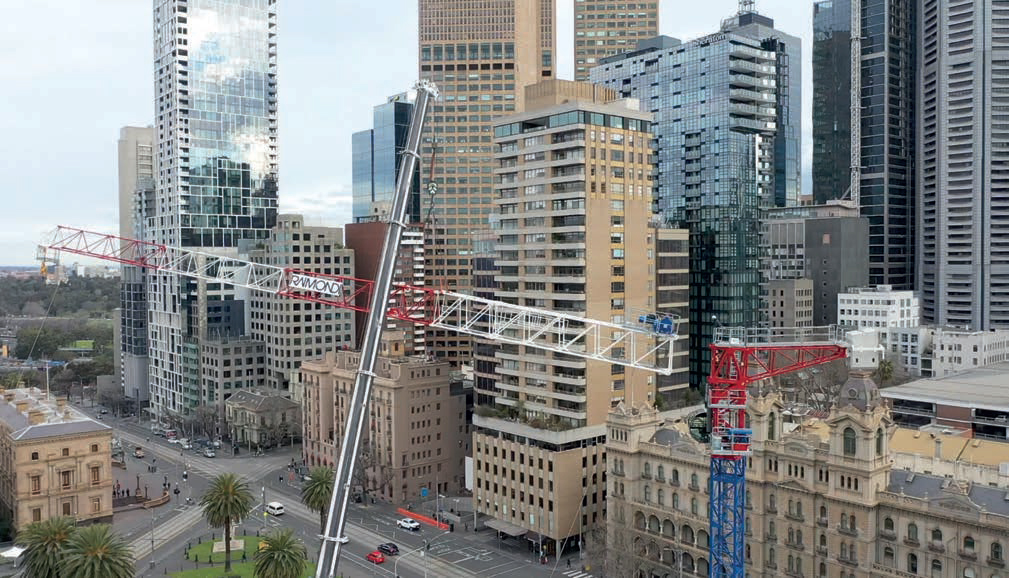 A Raimondi LRH 174 from the fleet of Clark Cranes being erected at the Parliament House in Melbourne, Australia.
A Raimondi LRH 174 from the fleet of Clark Cranes being erected at the Parliament House in Melbourne, Australia.
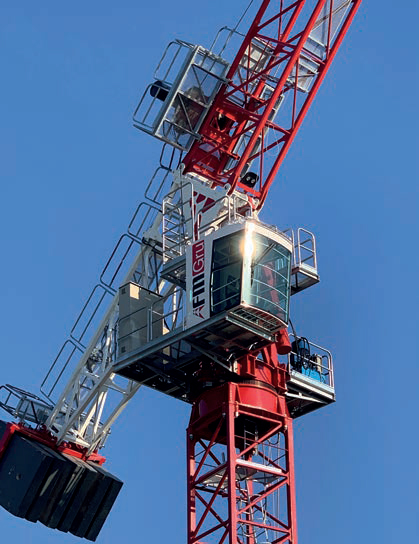 FM Gru’s FM 2052 LK has maximum jib length of 52m, maximum load of 5t with single fall or 10t with two fall.
FM Gru’s FM 2052 LK has maximum jib length of 52m, maximum load of 5t with single fall or 10t with two fall.
